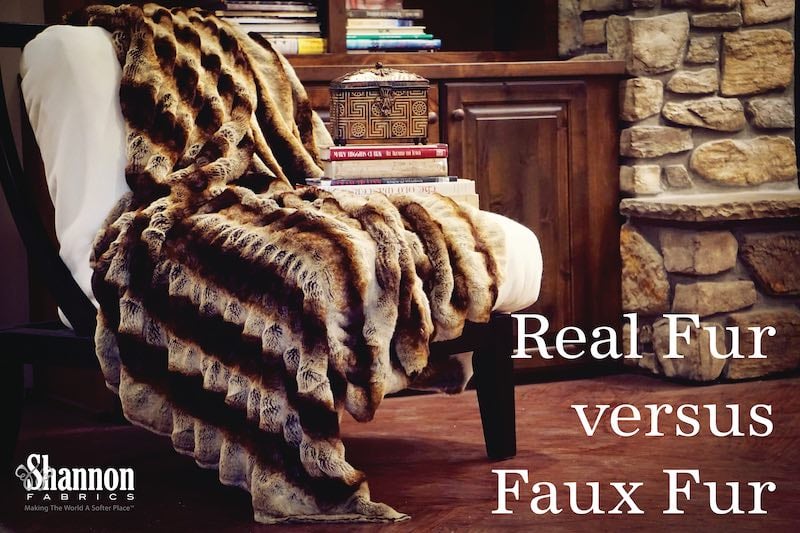How to Tell if a Fur Coat Is Real
It has become increasingly more difficult to tell the difference between real fur and faux (fake) fur. This isn't a surprise, as technical advances in the faux fur manufacturing process have closed the gap look-wise in recent years. This is a good thing from an ethical standpoint — sewists and designers can now get the same style and look for their garment, accessory or sewing project without harming a living animal. But since real fur and faux fur are virtually indistinguishable to the untrained eye, this can raise concerns when purchasing, let's just say, a jacket with fur accent pieces. How can you reliably tell the difference between real fur and faux (fake) fur fabric to avoid any missteps? Before we start comparing real fur and faux fur, we'll first define what they are individually. Due to the nature of the content, we won't go into specific examples or show any graphic imagery, but fair warning — the real animal fur industry is a highly controversial (and disturbing) topic. READ MORE: How Much Does Faux Fur Cost? A Guide to Faux Fur Prices Don't let this deter you — we'll provide all the information you'll need to make smart, informed decisions no matter if you're a consumer and shopping for yourself, or a sewist or designer looking for material and fabric for your next product line or sewing project. Here's a closer look at what faux fur is, what real fur is and how to tell the difference between real and faux fur. Faux fur and fake fur are two names that are used interchangeably in the fashion industry and sewing circles. More often than not, faux fur is a synthetic fabric made from a blend of acrylic and polyester fibers. And because it's a manmade fabric (no animals are harmed in making faux fur), it can be manufactured in just about any color imaginable and comes in different weights and pile heights (thicknesses). This allows manufacturers and wholesalers like Shannon Fabrics to offer both classic animal prints and some wild, eye-catching prints and textures not found in nature. READ MORE: What is Faux Fur? (Material, Textures, & Projects) Due to a huge shift in the fashion industry, most affordable designer name brands only offer "fur" apparel and accessories that are sewn with faux fur. It's not only more ethical and better for their brand image, but it's more affordable and easier to care for. Next time you see someone in public wearing something that looks like fur, don't be too quick to judge — it's likely faux fur. We may be a tad biased (in a good way) after selling faux fur for almost 25 years, but it's a fabric you truly have to feel in person to understand completely! If you're a little unsettled by the thought of real fur being used in apparel and accessories, we don't blame you. While you can certainly jump to the next section if needed, here we'll outline (as gently as possible) what real fur is and how it's "made". Real fur, also called genuine fur, is generally from foxes or rabbits, although lynxes, chinchillas and raccoons are also common animals raised for their fur. In order to keep production costs down, these animals are crammed into small cages with other animals, with disease, parasites and unbearably high levels of stress prevalent throughout the "farm" (the waste associated with these farms is highly toxic for the local environment, too). Over half of the world's genuine fur comes from Europe, and most of these animals live painful, short lives. We'll spare you the details on how they're slaughtered, but as expected, it's inhumane and disturbing. READ MORE: The 5 Best Faux Fur Wholesalers (Reviews/Ratings) Once the fur is harvested, it's treated with harmful chemicals to prevent decomposing before being used as trim, lining or as the main substrate of a piece. Accessories and garments with real fur can cost several thousands of dollars depending on the quality of the fur and how much fur is used. Now that we've covered what faux fur and real fur are, you're probably wondering how to tell the difference between real fur and faux fur. Luckily, there are several easy ways to determine if the fabric or article of clothing in question is real or fake. Note that not all of these are foolproof — it might take a combination of a few different methods to make sure you're not purchasing real fur. Run your fingers through the fur to part the hair/fibers — you should be able to see through to the base. This can get a tad more difficult with denser furs and fabrics. Real (genuine) fur will have the hair attached to its solid, natural leather base. Faux (fake) fur will have have the fibers attached to a knitted base that is often a similar color (and will stretch a bit). If possible, turn the fur in question over to check the backing — this will make it easier to see the leather or the knitted base. While this is ideal, note that if the fur in question is sewn into a garment or accessory, you won't be able to do this and you'll have to separate the fur from the front (as mentioned above). This one is simple — use a safety pin and try to push the tip through the fabric. The pin should easily pierce through faux fur due to the knitted base, and it will be noticeably tougher to push through the leather in genuine fur. While we wish telling the difference between real fur and fake fur is as simple as reading the label, be warned this can be misleading. If the label is marked as genuine or real fur, chances are it's right. Unfortunately though, a garment or accessory marked as faux fur can sometimes be real fur, so use the other methods listed here to determine if the label is correct. READ MORE: 8 Best Sewing Projects and Uses for Faux Fur Fabric Looking at the price is also another way to tell if the fur is real or fake. Real, genuine furs can cost thousands of dollars and are usually found in name-brand high-end shops. While this is generally the case, note that Chinese fur production has significantly lowered the price of genuine animal fur in recent years - making it more competitive. Burning a few of the hairs or fibers is a pretty reliable way to tell the difference between real fur and fake fur. We advise you use this tactic at home (instead of a store) in a safe, flame-proof space. Pull out a few hairs/fibers from an inconspicuous spot on the garment, and hold them to a lit match (ideally over a sink). Faux fur will curl and smell like melted plastic, and real genuine fur will singe and smell like burnt hair. This one is also subjective and works best when you can compare a real fur garment and a fake fur garment next to each other. Despite looking deceptively similar to real genuine fur, faux fur can have a completely different feel depending on the quality of the synthetic fibers. Genuine fur is usually soft, smooth and dense like a dog's or cat's coat, and the hair will easily part as you slide your fingers through it. Faux fur, especially less expensive faux fur, can often feel more coarse, and if your hands are damp or moist, will sometimes stick to your fingers. As you can see, there are some pretty stark differences between real fur and faux fur despite looking so similar. Luckily, throughout our 25 years of being in the fabric and textile industry, we've seen a major shift from manufacturers and fashion brands using real furs to opting instead for faux fur. Despite this, the animal fur industry is still a multi-billion dollar global industry that is fueled by demand from often uninformed consumers. READ MORE: 7 Must-Try Faux Fur Sewing Tips By keeping the tips listed above in mind, you'll be able to make smart, sustainable decisions without sacrificing style, form or function. Do your research — only align with brands who are transparent with their business practices, and who publicly make a stance against using real animal fur in their collections and products. Here at Shannon Fabrics, we offer over 130 different faux furs that are not only free from animal products, but are super durable, weaved with top-shelf synthetic yarn and are as soft and cozy as you'd expect. We've created a library of free tips and tricks, patterns and videos to not only educate, but to share our love of sewing with this ethical, irresistible fabric. If you have any questions about faux fur or how to use faux fur in your next sewing project, feel free to contact our team of friendly, no-pressure customer service team at 866-624-5252. Feeling inspired? Use our store locator to find faux fur fabric near you. 
What is faux fur?
What is real fur?
How to tell the difference between real fur and fake fur
Separate the hair/fibers and look at the base to tell the difference between real fur and fake fur
Push a pin through the back of the material to tell the difference between real fur and fake fur
Look for the price and read any attached labels to tell the difference between real fur and fake fur
Burn a few of the hairs/fibers to tell the difference between real fur and fake fur
Use the touch test to tell the difference between real fur and fake fur
Parting thoughts - real fur vs. faux fur fabric

PETA, real fur vs. fake fur, Sewing, education, fabric, fake fur, Faux Fur, Faux Fur Tips, genuine fur, Fashion, how to tell the difference between faux fur and re, what is faux fur, what is faux fur fabric
How to Tell if a Fur Coat Is Real
Source: https://blog.shannonfabrics.com/blog/2019/09/27/real-genuine-fur-versus-faux-fake-fur-compared
0 Response to "How to Tell if a Fur Coat Is Real"
Post a Comment